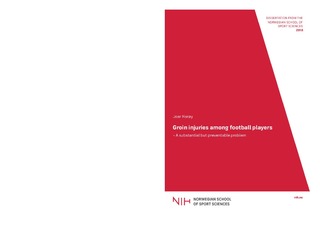| dc.description.abstract | Background: Groin injuries represent a considerable problem in football and account for 4% to 19% of all time loss injuries among male players. Until now, groin-specific exercise programmes have not shown a significant effect on groin injury rates. However, since the programmes were designed, there have been new data published on hip adduction exercises in the context of both muscle activation and strength effects. The overall aim of this dissertation was to develop and examine the effect of an Adductor Strengthening Programme on the prevalence of groin problems among male football players. We also wanted to test a new method for registering groin problems among players of both sexes and different levels of play. In addition, we wanted to examine the strength and sprint effect of the FIFA 11+ warm-up programme. Finally, we examined players’ attitudes towards groin injury prevention and their experiences with the implementation of the Adductor Strengthening Programme.
Methods: The dissertation is based on four different research projects. In the first project (Paper I), we used the Oslo Sports Trauma Research Center Overuse Injury Questionnaire in a six-week prospective registration of groin problems among 240 players during a period with match congestion. In the second project (Paper II), we examined the strength effect of the FIFA 11+ with and without the Copenhagen Adduction exercise, in an eight-week randomised controlled trial among 45 male U19 players. In the third project (Paper III), 632 players were enrolled in a 28-week cluster randomised controlled trial examining the preventive effect of an Adductor Strengthening Programme based on the Copenhagen Adduction exercise. In project four (Paper IV), 501 of the players included in Paper III responded to a survey about their experiences with the implementation of the Adductor Strengthening Programme and their attitudes towards groin injury prevention.
Main results: The average weekly prevalence of any groin problem and substantial groin problems for all male players was 29% (range, 23% to 32% across different levels) and 10% (7% to 13%) respectively. For elite female players, the prevalence of any groin problem was 14%, while the prevalence of substantial groin problems was 4%. Elite male players had an increased risk of groin problems (odds ratio: 3.1, 95% CI: 1.5-6.4, p=0.03) compared to elite female players. There was no difference in the risk of groin problems among elite, sub-elite and amateur male players (Paper I). In Paper II, between-group analyses revealed a significant increase in eccentric hip adduction strength of 0.29 Nm/kg (8.9%, p=0.01) in favour of the group performing the Copenhagen Adduction exercise, whereas no within-group change was noted in the group that used the standard FIFA 11+ programme (-0.02 Nm/kg [-0.7%], p=0.69). In Paper III, the average prevalence of groin problems during the regular season was 13.5% (95% CI: 12.3% to 14.7%) in the group performing the Adductor Strengthening Programme and 21.3% (95% CI: 20.0% to 22.6%) in the control group continuing normal training. The risk of reporting groin problems was 41% lower for the group performing the programme (odds ratio: 0.59, 95% CI: 0.40 to 0.86, p=0.008). Paper IV showed that most players think footballers are at moderate to high risk for groin injuries (87%) and that there is a need for preventive measures (96%). They also believe that a preventive programme with strength exercises targeting the hip adductors would reduce the risk of groin injury (91%). A majority of players reported using less than five minutes to complete the Adductor Strengthening Programme (73%), and only 11% wanted additional exercises. However, only 46% reported performing the programme as recommended, and a smaller proportion (31%) planned to continue using the programme as recommended the next season.
Conclusions: We found a high prevalence of groin problems among male football players during a period with match congestion. Elite male players had 3 times’ higher risk of reporting groin problems than elite female players, but level of play did not influence the risk of reporting groin problems among males. We also found that the standard FIFA 11+ programme did not increase eccentric hip adduction strength, while including the Copenhagen Adduction exercise in the programme provided the missing strength effect. The Adductor Strengthening Programme substantially reduced the prevalence and risk of groin problems in male football players. Finally, we found that footballers believe that groin injury prevention measures are needed. Attitudes towards the implementation of the Adductor Strengthening Programme were positive, and the single-exercise approach was considered an important facilitator. However, in disseminating the programme, the players’ reluctance to maintain the exercise protocol may be a potential barrier to implementation that should be addressed. | nb_NO |
